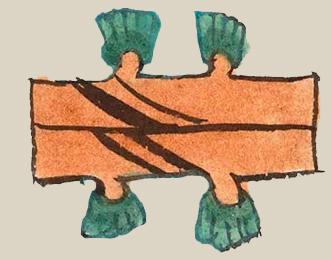cuahuitl (Mdz32r)
This element for trees (cuahuitl) has been carved from the compound sign for the place name, Cuauhpanoayan. It consists of two tree trunks lying horizontally, each one with two branches with two-tone greenery, terracotta-colored bark, and diagonal stripes across the trunks.
Stephanie Wood
The shape and direction of these trees are affected by the meaning of the compound glyph from which they were carved, which pointed to a wooden surface upon which people could cross a river or the like. The black stripes (tlilcuahuitl) are phonetic indicators that this sign is a tree (cuahuitl), something I discovered independently, but which has also been pointed out by Brígida von Mentz ("De árboles, raíces, y locativos en la iconografía del México antiguo," Tlalocan 15, 2008, 216–219).
Stephanie Wood
c. 1541, but by 1553 at the latest

cuahui(tl), tree(s), https://nahuatl.wired-humanities.org/content/cuahuitl-1
tlilcuahui(tl), black stripe(s), https://nahuatl.wired-humanities.org/content/tlilcuahuitl
tree
Codex Mendoza, folio 32 recto, https://digital.bodleian.ox.ac.uk/objects/2fea788e-2aa2-4f08-b6d9-648c00..., image 74 of 188.
The Bodleian Libraries, University of Oxford, hold the original manuscript, the MS. Arch. Selden. A. 1. This image is published here under the UK Creative Commons, “Attribution-NonCommercial-ShareAlike 3.0 License” (CC-BY-NC-SA 3.0).

